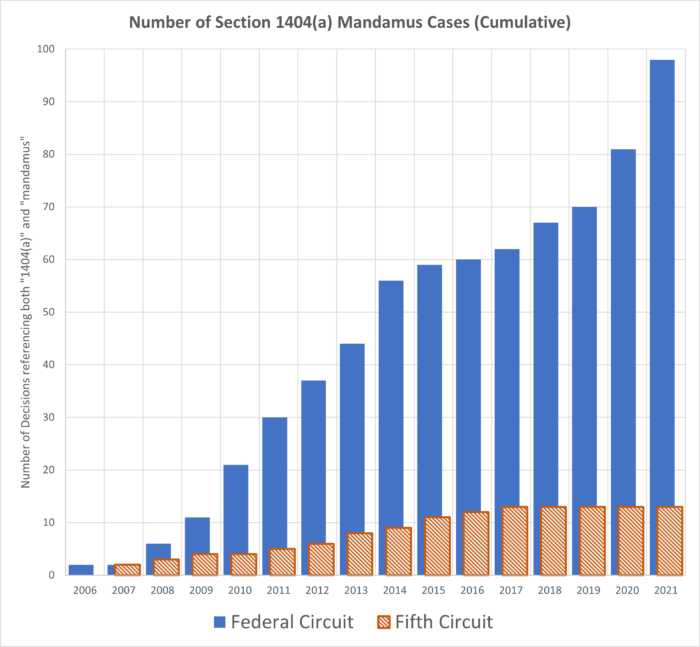by Dennis Crouch
An oddity of patent litigation jurisprudence is that Section 1404 determinations are not deemed patent-law specific. Thus, the district court is bound to follow the law of the regional circuit court. And, although patent-litigation mandamus petitions go to the Federal Circuit, the appellate court purports to apply the law of the relevant regional circuit court. Since most of the transfer cases before the Federal Circuit are originally filed in Texas, the Federal Circuit regularly applies Fifth Circuit law.
The chart above comes from a simple Westlaw case search of appellate decisions referencing both Section 1404(a) and mandamus. What you’ll notice is a relatively large number of decisions from the Federal Circuit, the vast majority of these out of the Fifth Circuit region. Anyone following the cases will also know that the Federal Circuit has substantially advanced the doctrine over the past 4 years, even though during that time the FifthCircuit has not decided any Section 1404 cases. By the time the Fifth Circuit hears another mandamus petition, I expect that the court may be a bit shocked to see where their doctrine has gone.
One note on this data – Prof. Jason Rantanen has written about missing appellate decisions, and mandamus decisions are right in the sweet-spot of decisions that potentially don’t find their way into Westlaw. So, bottom line is that these numbers are likely an undercount. https://papers.ssrn.com/sol3/papers.cfm?abstract_id=3927406
And on the flipside, you have CA5 less than two months ago ruling on FRAND issues, which to me seem to belong a lot more sensibly in CAFC’s wheelhouse. Go figure.
The CAFC scarcely covered itself in glory with today’s In re Google opinion. I am generally in favor of the CAFC leaning on WD Tex to transfer cases in the interests of justice, but it was hard to square the nitpicking of today’s order with an “abuse of discretion” standard of review.
Is this mandamuses chart for the Fed. Cir. just for Texas cases, and is it perhaps indicative of an increasing attention span issue? I found the following news item interesting:
“The average attention span for the notoriously ill-focused goldfish is nine seconds, but according to a new study from Microsoft Corp., people now generally lose concentration after eight seconds, highlighting the affects of an increasingly digitalized lifestyle on the brain.”
This is no joke. With all of these mandamus orders that we are seeing lately, I am struck by how detailed is the analysis that the CAFC is requiring for each of the CA5’s Volkswagen factors. I doubt that the CA5 has ever had occasion to think about any of these factors in so much detail.
I would not be surprised if they never will have to consider this level of detail, but if they do, it will be interesting to see whether they agree with the CAFC’s thinking. It would be a real kicker if the CA5 were to read the factors in the way that Judge Albright had read them originally.
That would be funny – the CAFC being slapped from both above and below.
Comments are closed.